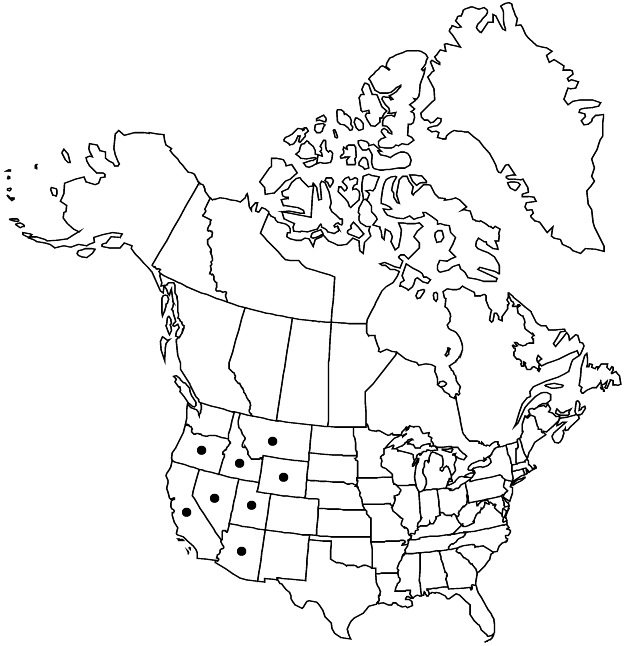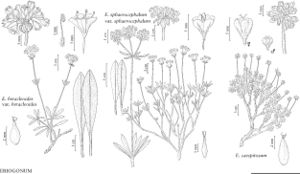Difference between revisions of "Eriogonum caespitosum"
J. Acad. Nat. Sci. Philadelphia 7: 50, plate 8, fig. 2. 1834.
FNA>Volume Importer |
FNA>Volume Importer |
(No difference)
| |
Revision as of 22:37, 16 December 2019
Herbs, matted, polygamodioecious, (0.1–)0.3–1 × 1–5(–12) dm. Stems: caudex spreading; aerial flowering stems scapelike, ascending to weakly erect, slender, solid, not fistulose, arising at nodes of caudex branches and at distal nodes of short, nonflowering aerial branches, (0.1–)0.3–0.8(–1) dm, mostly floccose or glabrous, without a whorl of bracts. Leaves in compact basal rosettes; petiole 0.05–0.4(–0.7) cm, usually tomentose; blade elliptic to obovate or nearly oval, 0.2–1(–1.5) × 0.15–0.4(–0.5) cm, grayish- to whitish-tomentose on both surfaces or less so and greenish adaxially, margins entire, plane. Inflorescences capitate, 0.5–2 cm wide; branches absent; bracts absent immediately below involucre. Involucres 1 per node, campanulate, 2–3.5 × 2–4 mm; teeth 6–9, lobelike, strongly reflexed, 2–3.5 mm. Flowers 2.5–10 mm, including 0.5–1 mm stipelike base; perianth yellow to reddish or rose, densely pilose to villous abaxially; stamens exserted, 3–4 mm; filaments pilose proximally; staminate flowers shorter, 2.5–4 mm, tepals monomorphic, oblong-oblanceolate; pistillate flowers 2.5–10 mm, tepals slightly dimorphic. Achenes light brown to brown, (3.5–)4–5 mm, glabrous or sparsely pubescent on beak.
Phenology: Flowering Apr–Jul.
Habitat: Sandy to gravelly flats and slopes, mixed grassland, saltbush, sagebrush, and mountain mahogany communities, oak, pinyon and/or juniper and montane conifer woodlands
Elevation: (1300-)1500-3000(-3700) m
Distribution

Ariz., Calif., Idaho, Mont., Nev., Oreg., Utah, Wyo.
Discussion
Eriogonum caespitosum is widespread and usually common. It is variable throughout its range but no taxonomic subunits have been noted. The functionally staminate plants can be morphologically different from the functionally pistillate ones, and that may cause some confusion in the field, especially when the latter are in fruit. The plants are widely cultivated and worthy of consideration for the rock or sand garden. Plants from along the eastern edge of the Sierra Nevada in southern Mono County, California, form large, dense mats and would be most attractive in the garden. The scapelike flowering stem is technically a peduncle, being a further reduction of the inflorescence from that seen in E. douglasii. A specimen supposedly gathered in Nebraska (Abbott s.n., CAS) is discounted as to location.
Selected References
None.
